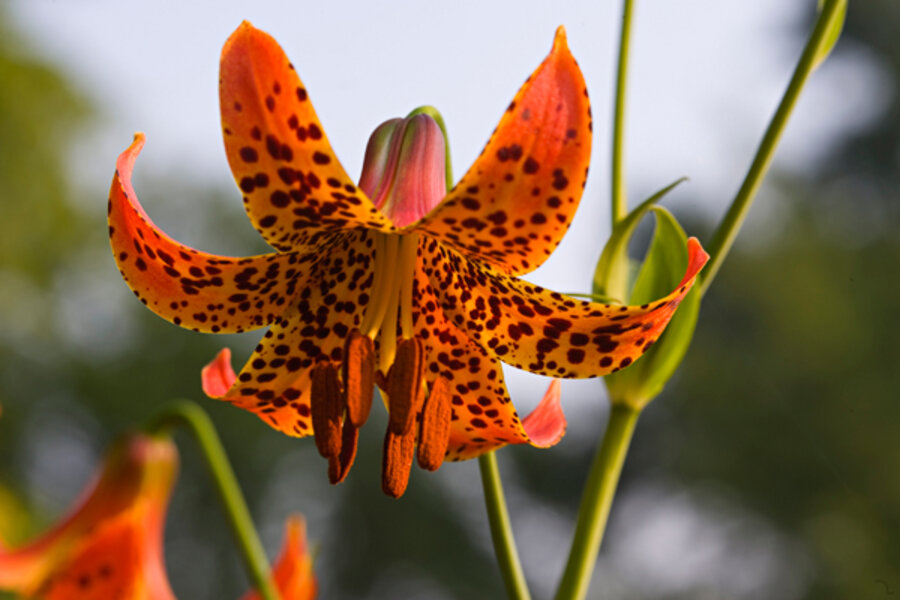Why didn't I plant more martagon lilies?
Loading...
Ah, March.
Recently we hit 50 degrees F. (10 C) outside, rain came down in buckets, the snow pack melted, and, braving the downpour, I discovered charming little clumps of white snowdrops (Galanthus spp) and patches of warm buttercup yellow winter aconites (Eranthis hyemalis) canoodling with the plump new buds of hellebores throughout my woodland borders.
Looking at these first floral harbingers of spring, I know that once again, Persephone, the beautiful Greek mythological goddess of innocence associated in a big way with the coming of spring, is getting ready to once again make her appearance.
And thoughts of Persephone -- in their own quirky manner -- lands my mind on thoughts of pure, gleaming white, heavenly scented ‘Casa Blanca’ Oriental lilies [see second photo at left] – and the fact that I really should have planted more of these glamorous showgirls in my garden last fall.
Though fall-planted lily bulbs have the advantage of developing well-established roots before the growing season begins, lily (Lilium) bulbs can still be purchased in the spring for that season’s bloom. And since I’m not a perfect gardener – who among us is? – I’m on a mission right now to purchase some additional bulbs knowing full well that although I’ll stress the plants a bit this season, they’ll recoup to produce full-sized dazzling, pristine blossoms the year after.
While the term “lily” is applied to many different plants, “true or hardy lilies” belong only to the genus Lilium.
Let me tell you, on any warm, sultry summer’s evening, there is nothing that can compare to the intoxicating perfume of lilies wafting across the garden. The scent is unmistakably heady.
And with looks ranging from the elegant to the exotic, lilies are the center of attention in any landscape. Certainly, these garden idols have it all: classic beauty and grace, dazzling color, and a stately presence – whether growing in the garden or displayed indoors in a vase.
Best yet, they are every “lazy gardener’s dream”: Just plant, stand back and watch them explode out of the ground.
True lilies grow from scaly bulbs and are easy-to-grow, long-lived garden plants. The lily family, comprised of nine major divisions, produce tall, upright plants with whorls of leaves running the length of the stem and blossoms that can be bell-, bowl-, trumpet-, flat-, or turk’s cap-shaped, facing every which way and borne singularly or in groups.
Lilies come in a wonderful range of colors – from pale shades like white, pink, peach, and lavender to the bold and brassy screamers such as crimson, neon-orange, and purple.
A long season of colorful bloom
Here in northern Illinois, the typical lily season lasts about four months, beginning with the first blooms of my favorite lily, martagon (or Turk’s caps), in early June.
Growing three- to six feet tall, the stately martagons and their hybrids come in many colors, including pink, maroon, mahogany, yellow, white, and almost black – many with speckles and spots. These long-stemmed beauties are long-lived – colonies have been known to survive 80 years or more – eventually forming large clumps with up to 50 buds on one stem.
Flowers open from the bottom up to reveal dancing clusters of demure, waxy, downward-facing blossoms. Martagons began life as woodland denizens, thus they are better able to handle shade, making them wonderful, colorful companions in hosta beds or woodland gardens.
Grown for centuries, still not well-known
I am constantly amazed by the fact that this wonderful plant continues to remain relatively unknown despite having been in cultivation for centuries. John Gerard, author of the famous Elizabethan botanical guide “Herbal,” mentions them in a list of plants growing in his garden – in 1596, no less.
True, they do not flaunt the large, showy blossoms or the intense fragrance of the Oriental hybrids; still, they have a subtle sophistication that their Vegas showgirl cousins lack. (And why didn’t I plant more of these glorious bulbs last fall?)
Though martagons are not difficult to grow, they require patience from the gardener. They may tackle the coldest winters with ease, but they are incredibly persnickety about being moved.
I sited my first bulbs in the wrong spot, and after transplanting them in the spring – definitely a no-no – they threw a hissy-fit and did not come up the following year.
It wasn’t until a full two seasons later, a time when I had just about given up on them, that they surprised me with a season of growth and some bloom … but I can honestly say, the ethereal blooms were more than worth the wait.
Betty Earl is one of nine garden writers who blog regularly at Diggin' It. She's the author of “In Search of Great Plants: The Insider’s Guide to the Best Plants in the Midwest.” She also writes a regular column for Chicagoland Gardening Magazine and The Kankakee Journal and numerous articles for Small Gardens Magazine, American Nurseryman, Nature’s Garden, and Midwest Living Magazine, as well as other national magazines. She is a garden scout for Better Homes and Gardens and a regional representative for The Garden Conservancy.
-----
To read more by Betty Earl, click here. For more Monitor gardening, see our main gardening page and all the posts of Diggin' It (scroll down to see more). Both have new URLs, so we hope you'll bookmark them and return.







